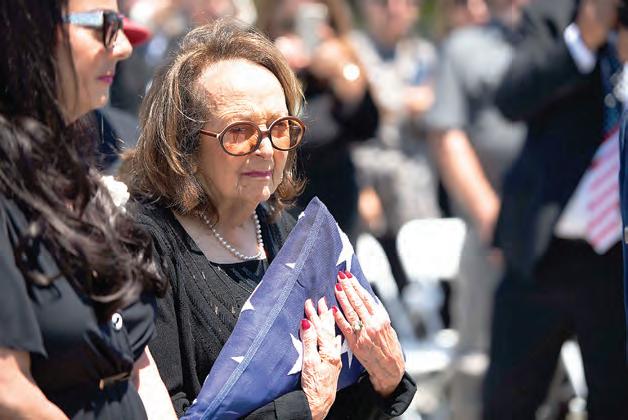
3 minute read
Uniforms? Check. Now the Space Force needs an identity
The Washington Post CAPE CANAVERAL, Fla. —
The uniforms resemble costumes from the television series “Battlestar Galactica,” and the logo is right out of Star Trek. Even the name given its members, “guardians,” seems born of science fiction. But three years after it was established as the sixth branch of the U.S. Armed Forces, the U.S. Space Force is very much a reality.
It has a motto, “Sempra Supra” or “Always Above,” fitting for an agency whose future is outside Earth’s atmosphere. It has an official song, a short, melodic anthem about guardians “boldly reaching into space” that’s not as catchy as “The Army Goes Rolling Along.” It has a budget ($26 billion last year, similar to NASA), bases across the country and a mission to transform the military’s relationship to the cosmos at a time when space has moved from being a peaceful commons to a crucial front in military conflict.
“We are very much clearly in the next chapter of the Space
Force,” Gen. David Thompson, the vice chief of space operations, said during a recent event hosted by the Mitchell Institute for Aerospace Studies. The mission of the Space Force now is to become an “enterprise that really makes sure that we’re ready to deliver warfighting capabilities.”
What that means in practice is still unclear: The Space Force remains one of the least understood arms of the federal government. Its culture and identity are still being molded, as its leaders push to set the department apart from the Air Force, Navy and Army by arguing that as a new, smaller service it is free to do things differently. While the Air Force has more than 300,000 service members, there are only 13,000 guardians.
Internally, Space Force officials are still debating its priorities, analysts say: Is it to support warfighters on the ground? Or should it focus primarily on protecting assets in space? Or both? And despite all the talk of starting fresh and moving nimbly, the Space Force still exists within the rigid walls of the Pentagon, the world’s largest bureaucracy, which is often faulted for resisting change.
When Space Force Gen. Chance Saltzman, chief of space operations, introduced tenets to guide the force, he labeled them “A theory of success,” rather than a doctrine because he wants them to continue to evolve.
“I’m proposing this theory so that people will debate with me,” he said during an event earlier this year at the Center for Strategic and International Studies in Washington. “So we’ll get better at figuring out what are the nuances that matter, what are the details that we to continue to refine.”
A glimpse of what the Space Force has become, and aspires to, can be seen on the Florida Space
Coast, where the Space Age was born in the United States and where a new space era, driven largely by a growth in the private space industry, is taking hold.
Propelled largely by Elon Musk’s SpaceX, the number of launches here has not only increased, but the topography of the place has changed. Landing pads for SpaceX’s reusable See SPACE FORCE Page 7 rockets and historic launch sites - like pad 39A that launched the Apollo astronauts to the moonare now in private hands.

New companies, such as Jeff Bezos’ Blue Origin, are taking over launchpads that had sat vacant for decades, trying to get their rockets into orbit as well. (Bezos owns The Washington Post.) Even the official name has changed: It is now Cape Canaveral Space Force Station.
The growth is remarkable. In 2021, 31 rockets blasted off from the facilities run by NASA and the Space Force. Last year, the number jumped to 57, and this year it’s expected to exceed 90.




With some thinking that number will eventually exceed 200, 300 or even more, a top Space Force general decided he needed help managing the traffic. So last spring, Maj. Gen. Stephen Purdy, the commander of the 45th Space Wing, which oversees the base, arranged a meeting for a couple dozen of his staff at a place where many loathe to go but that is used to sending large numbers of vehicles into the sky at a regular cadence: Orlando International Airport.
During the visit to the Orlando airport, “our folks got a lot of good ideas,” he said in an interview in










